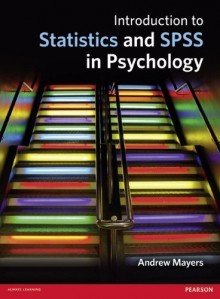Review of Introduction to Statistics and SPSS in Psychology
Author – Andrew Mayers
Publisher – Pearson
ISBN – 978-0-273-7301-6 (print)
Also available in PDF and e-text
The official Pearson promotion site is https://catalogue.pearsoned.co.uk/assets/hip/gb/uploads/ShowcaseSites/MayersShowcaseSite/index.html
This is a comprehensive resource of all the statistics you could ever want for degree level Psychology, let alone A-level.
It starts with explaining why psychologists need statistics in their toolbox; psychology is becoming more and more rigorous and scientific with the advent of MRI scanning, neurochemistry and so on, but there is also a need for tools to study data from large samples or populations. This is where statistics comes in.
Much psychological research involves lots of numbers which are easier to understand by plotting them on graphs and distilling them to a single statistic which carries a huge amount of meaning.
The trouble is, it all needs number-crunching – and this is where SPSS does most of it for you. SPSS is a program (renewable by licence) into which you put the data, use your chosen statistical test and press “Enter”. Well, nearly …
The book, together with SPSS, enables psychologists to do more psychology rather than more arithmetic.
The chapter on SPSS is virtually a manual for the program – and pretty technical.
Thankfully, the next few chapters are on the basics of statistics such as the Normal Distribution, statistical significance and how to choose the correct statistical test for the data obtained.
Following these, a chapter on each test (or group of tests) forms the bulk and remainder of the book.
What could help would be a decision tree for which test to choose for the type of data and size of sample used. For some of us, we just like to be told which test to use in a graphical, rather than text, form.
The book is intended as a teaching/learning tool so each chapter has “Learning Objectives” at the start, and a summary & questions at the end. It is unlikely that every Psychology student would need every chapter, but it is all there as a resource.
It also requires a mathematically-trained mind and a quiet room to get the best out of it!
Neil Cruickshank,
Psychology Teacher, Budmouth College, Weymouth







